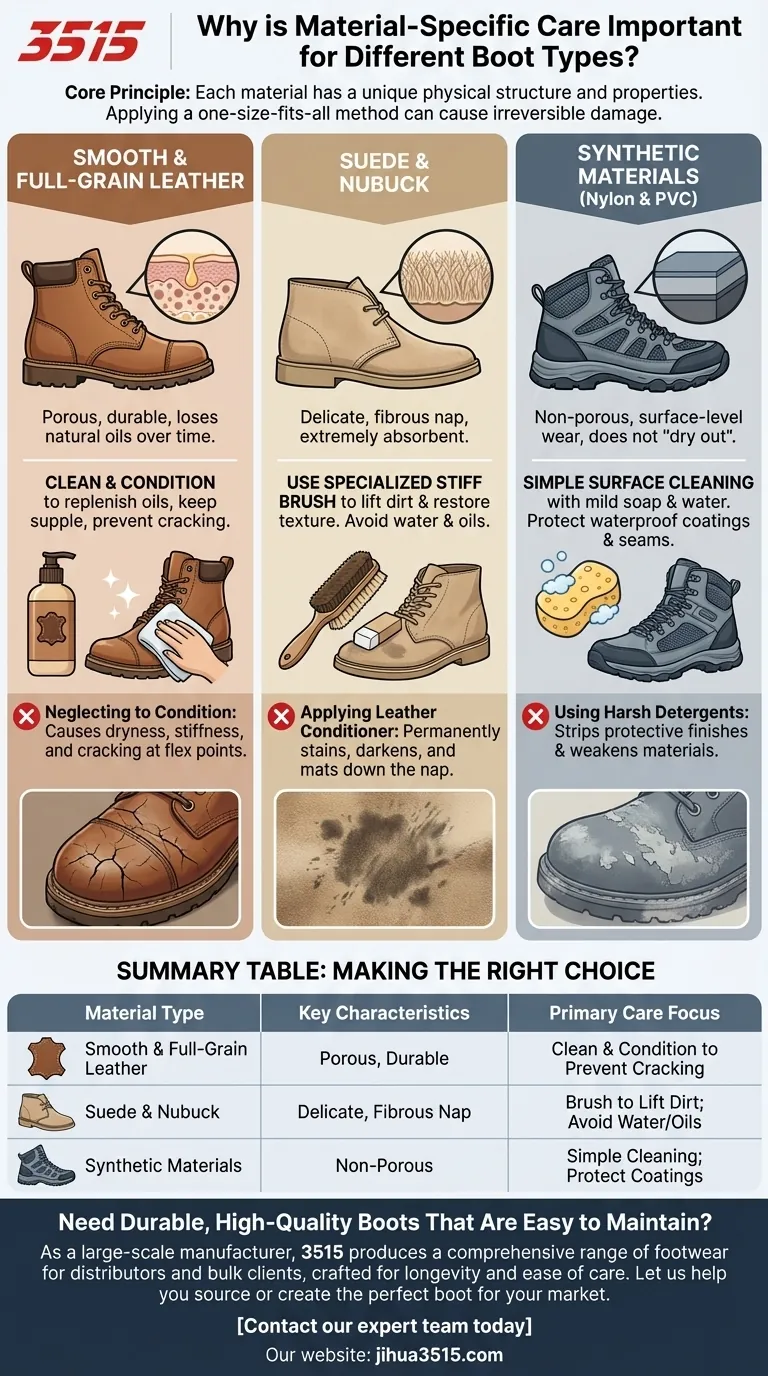Material-specific care is critical for boots because each material possesses a unique physical structure and properties. Applying a one-size-fits-all cleaning or conditioning method can cause irreversible damage, from matting the delicate texture of suede to drying out and cracking smooth leather. Proper maintenance works with the material's inherent nature to protect your investment and extend its life.
The core principle is simple: different materials have vastly different levels of porosity, texture, and durability. Your care routine must respect these differences to be effective, focusing on nourishing natural materials while protecting the surface integrity of synthetics.

The Core Principle: Understanding Material Properties
To care for your boots correctly, you first need to understand what you're working with. A boot isn't just a boot; it's a specific material with specific needs.
Smooth & Full-Grain Leather: Durability and Breathability
Full-grain leather is essentially a natural skin. It's durable and porous, meaning it breathes but can also lose its natural oils over time.
The goal of leather care is to clean the surface without stripping these oils and then to replenish them with a conditioner. This keeps the leather supple and prevents it from drying out, becoming brittle, and cracking at flex points.
Suede & Nubuck: The Challenge of the Nap
Suede and nubuck are leathers that have been sanded to create a soft, velvety texture called a nap. This fibrous surface is extremely delicate and absorbent.
Water is the primary enemy here, as it can easily stain and flatten the nap. Care focuses on using a specialized stiff brush to lift dirt out of the fibers and restore their texture, rather than using creams or polishes which would ruin it instantly.
Synthetic Materials (Nylon & PVC): Focus on Surface Integrity
Synthetics like nylon fabric panels or PVC (polyvinyl chloride) are non-porous materials. They do not absorb conditioners and do not "dry out" in the same way as leather.
Care for these materials is much simpler. The focus is on surface cleaning to remove dirt and mud, often with just mild soap and water. The main goal is to protect waterproof coatings and ensure seams remain sealed.
Understanding the Trade-offs: Common Care Mistakes
Using the wrong product is often worse than using no product at all. Understanding these common pitfalls is key to proper boot maintenance.
Applying Leather Conditioner to Suede
This is the most common and damaging mistake. Applying a cream or oil-based conditioner to suede will permanently stain the material, darken its color, and completely mat down the delicate nap.
Using Harsh Detergents on Any Material
Harsh chemical cleaners or household detergents can strip the protective finishes from synthetic boots and pull all the essential oils out of leather, causing it to become dry and weak.
Neglecting to Condition Leather
Failing to condition smooth leather boots is a slow but certain path to destruction. As the leather loses moisture, it becomes stiff. Every step you take puts stress on the material until it eventually cracks, usually across the toe box.
Making the Right Choice for Your Goal
Tailor your maintenance routine to the specific boots you own to ensure they last for years.
- If your primary focus is on smooth leather boots (e.g., dress boots, work boots): Prioritize regular cleaning and conditioning to keep the material supple and prevent cracking.
- If your primary focus is on suede or nubuck boots (e.g., desert boots, fashion styles): Concentrate on preventative waterproofing and using a dedicated suede brush to protect the delicate nap from stains.
- If your primary focus is on synthetic boots (e.g., rain boots, many modern hikers): Concentrate on simple surface cleaning with mild soap and inspecting seams and bonds for wear and tear.
By understanding the nature of your boots' material, you move from simply cleaning them to actively preserving your investment.
Summary Table:
| Material Type | Key Characteristics | Primary Care Focus |
|---|---|---|
| Smooth & Full-Grain Leather | Porous, durable, loses natural oils | Clean and condition to prevent drying and cracking |
| Suede & Nubuck | Delicate, fibrous nap, absorbent | Brush to lift dirt; avoid water and oils |
| Synthetic Materials (Nylon, PVC) | Non-porous, surface-level wear | Simple cleaning with mild soap; protect coatings |
Need Durable, High-Quality Boots That Are Easy to Maintain?
As a large-scale manufacturer, 3515 produces a comprehensive range of footwear for distributors, brand owners, and bulk clients. Our production capabilities encompass all types of shoes and boots, crafted with material longevity and ease of care in mind. Let us help you source or create the perfect boot for your market.
Contact our expert team today to discuss your footwear needs!
Visual Guide

Related Products
- Wholesale Classic Leather Lace-Up Ankle Boots for Brand Manufacturing
- Wholesale Leather Ankle Boots with Lug Soles for Custom Brand Manufacturing
- Wholesale Comfortable Business Casual Shoes Custom Manufacturing
- Wholesale Leather Derby Shoes Manufacturer | Customizable Business & Dress Footwear
- Factory Direct Wholesale Leather Comfort Shoes with Dial Closure
People Also Ask
- How does toe box design differ between men's and women's work boots? Fit for a Woman's Foot Anatomy
- What is the appeal of two-tone leather lace wingtip dress shoes? Bold Style & Timeless Elegance
- What factors should be considered when buying new lace-up boots? Find Your Perfect Fit & Purpose
- What benefits do dress boots provide? Style, Support & Versatility for Any Occasion
- What are the key tips for wearing lace-up boots properly? Achieve Perfect Fit & Comfort

















